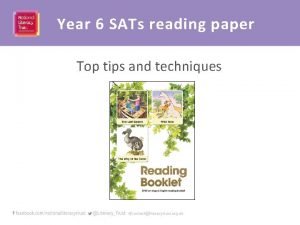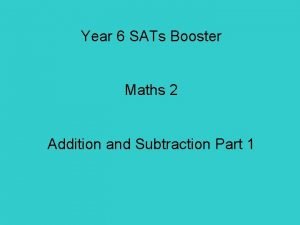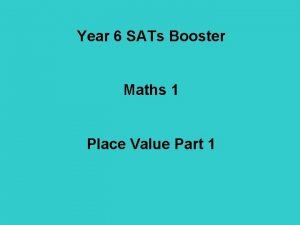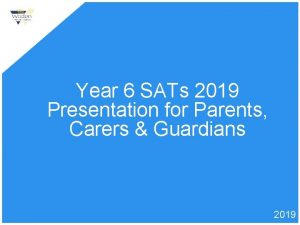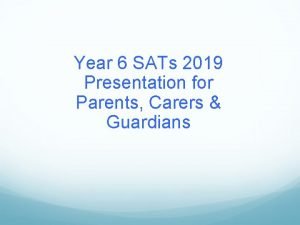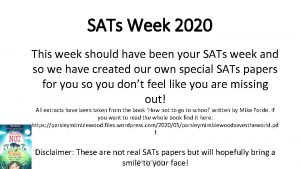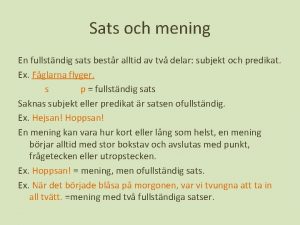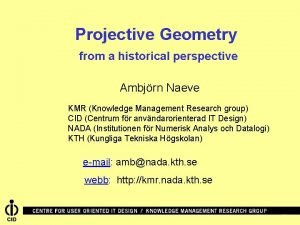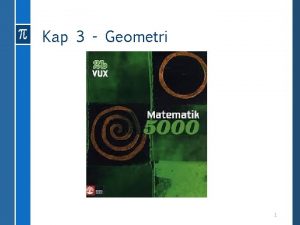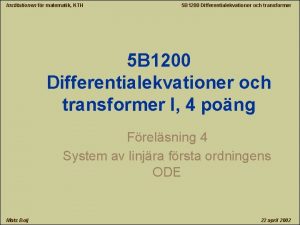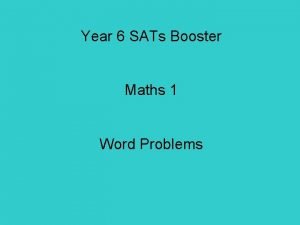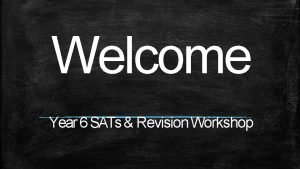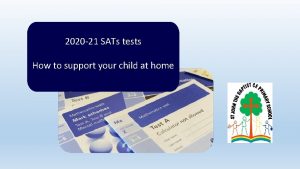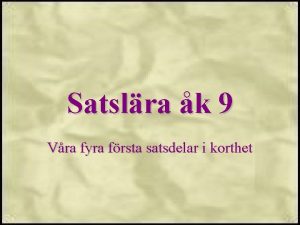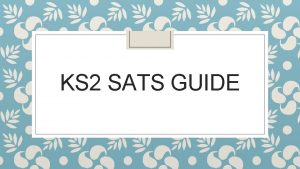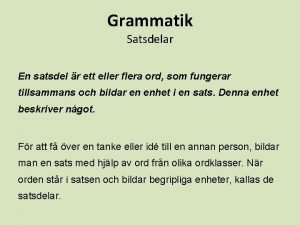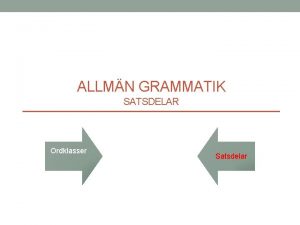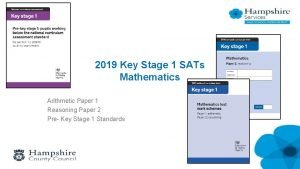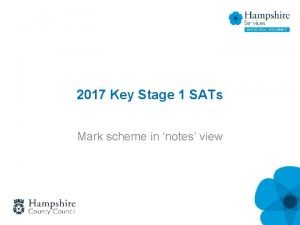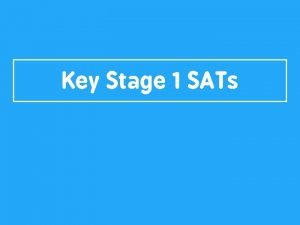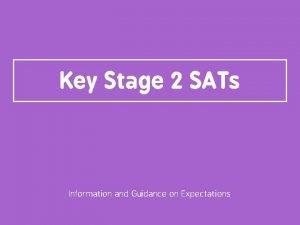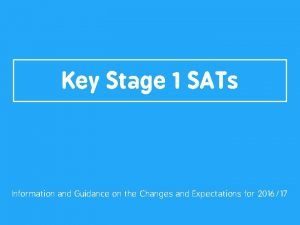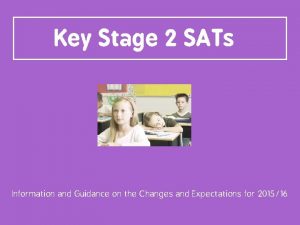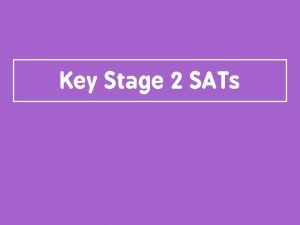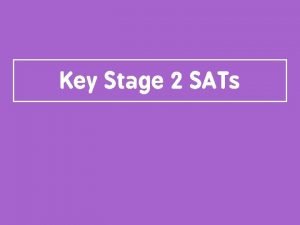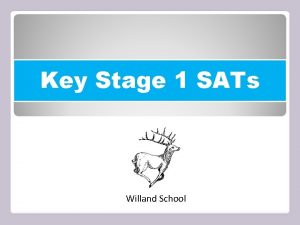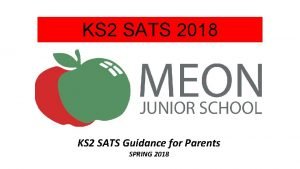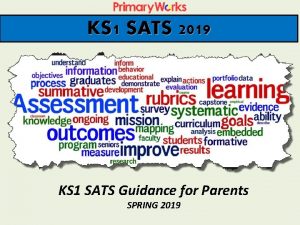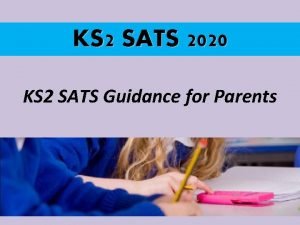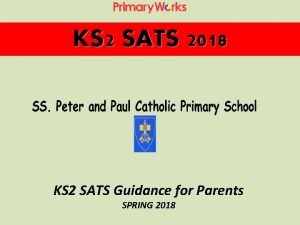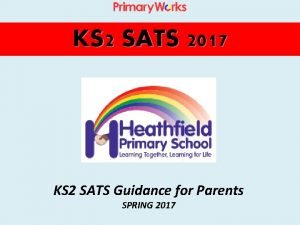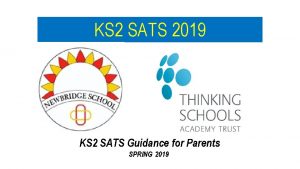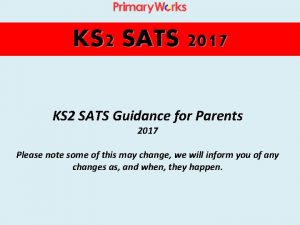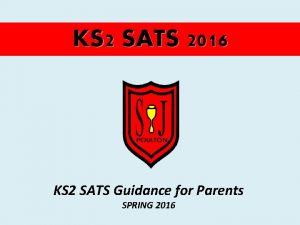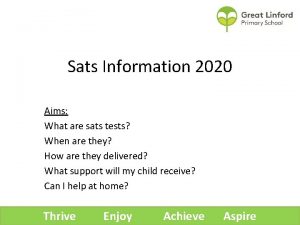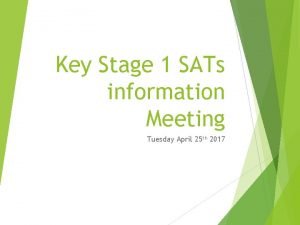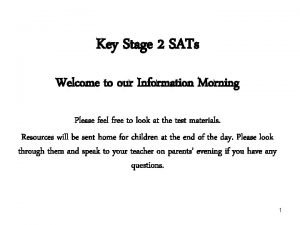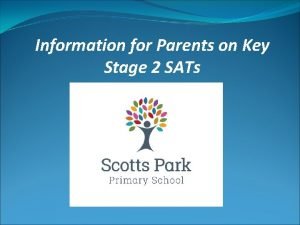Key Stage 2 SATs Information and Guidance on






















- Slides: 22

Key Stage 2 SATs Information and Guidance on the Changes and Expectations for 2016/17

Key Stage 2 SATs • In 2014/15 a new national curriculum framework was introduced byby the government forfor Years 1, 3, 4 and 5 5. • However, • In 2015/16 Years children 2 and in 6 all(due years to at statutory Key Stage testing) 1 andcontinued 2 were expected to study to thestudy the previous new national curriculum. for one further year. • In • 2016/2017 2015/16 children is the in second all years Year atthat Key Year Stage 6 1 children and 2 are willexpected be assessed to now against study the new national curriculum. • KS 1 (Year 2) and KS 2 SATs (Year 6) will reflect the new curriculum for the first time this year. • If your child is in Year 6 this year, they will be the first pupils to receive the new tests and the first to receive the new style of reporting results.

Assessment and Reporting • ‘Old’ national curriculum levels (e. g. Level 3, 4, 5) have now been abolished, as set out in the government guidelines. From scores 2016, test will beasreported as ‘scaled scores’. • Test will scores be reported ‘scaled scores’. it isstill very to compare the assessment a previous with • This Yourmeans child will be difficult taught with the highest expectationsofand cover allyear required the current elements ofyear. the curriculum, similar to previous years. childcurriculum will still beistaught with the and highest and cover • Your The new more rigorous setsexpectations high expectations whichallallrequired elements of the similar to previous years. schools have hadcurriculum, to work hard to meet since the beginning of last year. • The new curriculum is more rigorous and sets high expectations which all schools have had to work hard to meet since the beginning of last year.

Scaled Scores • What is meant by ‘scaled scores’? • It is planned that 100 will always represent the ‘national standard’. • Each pupil’s raw test score will therefore be converted into a score on the scale, either at, above or below 100. • The scale will have a lower end point somewhere below 100 and an upper end point above 100. • A child who achieves the ‘national standard’ (a score of 100) will be judged to have demonstrated sufficient knowledge in the areas assessed by the tests. (which cover curriculum content from Yr 3 – 6). • In July 2016 for the first publication of test results, each pupil will receive: • In o July A raw 2017 score for the (number publication of raw of test marks results, awarded). each pupil will receive: o A raw scaled score (number in eachoftested raw marks subject. awarded). o. A Confirmation scaled score ofinwhether each tested or notsubject. they attained the national standard. o Confirmation of whether or not they attained the national standard.

Scaled Score Examples On publication of the test results in July 2017: 2016: • A child awarded a scaled score of 100 is judged to have met the ‘national standard’ in the area judged by the test. • A child awarded a scaled score of more than 100 is judged to have exceeded the national standard and demonstrated a higher than expected knowledge of the curriculum for their age. • A child awarded a scaled score of less than 100 is judged to have not yet met the national standard and performed below expectation for their age.

Higher Attaining Pupils • Previous Key Stage 2 tests were aimed at children achieving Levels 3 -5 (with a national expectation to reach at least Level 4) • In the past, additional Level 6 tests were produced for children who demonstrated higher than expected attainment, above Level 5. • From Like last thisyear, therewon’tbe beany anyseparatetestsfor forthe themostablechildren. • Instead, each test will have scope for higher attaining pupils to show their strengths. This scaled score was 110 or above last year.

The Tests • Key Stage 2 SATs take place nationally in the week commencing 8 th 9 th May 2017. 2016. • Statutory tests will be administered in the following subjects: o Reading (60 minutes) o Spelling (approximately 15 minutes) o Punctuation, Vocabulary and Grammar (45 minutes) o Mathematics - Paper 1: Arithmetic (30 minutes) - Paper 2: Reasoning (40 minutes) - Paper 3: Reasoning (40 minutes) • In addition, some schools will be required to take part in Science testing, consisting of three tests in Biology, Physics and Chemistry. Not all schools will take part in this sampling, which takes place on a later date. • All tests are stored under VERY strict conditions • All tests are externally marked. • Writing will be ‘Teacher Assessed’ internally, as in recent years. In 2016 our Year 6 writing was moderated to validate our teacher assessments.

Reading • The Reading Test consists of a single test paper with three unrelated reading texts. • Children are given 60 minutes in total, which includes reading the texts and answering the questions. • A total of 50 marks are available. • Questions are designed to assess the comprehension and understanding of a child’s reading. • • Some questions are multiple choice or selected response, others require short answers and some require an extended selected response, others require short response or explanation. answers and some require an extended response or explanation.

Spelling, Punctuation and Grammar • A Spelling test is administered containing 20 words, lasting approximately 15 minutes. • A separate test is given on Punctuation, Vocabulary and Grammar • This test lasts for 45 minutes and requires short answer questions, including some multiple choice. • Marks for these two tests are added together to give a total for Spelling, Punctuation and Grammar.

Questions Grammar, Punctuation and Spelling Paper 1

Questions Grammar, Punctuation and Spelling Paper 1

Mathematics • The Children Mathematics will sit three tests: have. Paper undergone 1, Paper the 2 biggest and Paper change 3. this year. • Children Paper 1 iswill forsit ‘Arithmetic’ three tests: lasting Paperfor 1, 30 Paper minutes, 2 and covering Paper 3. calculation methods for all operations, including use of fractions, percentages and decimals. • Paper 1 is for ‘Arithmetic’ lasting for 30 minutes, covering calculation methods • for Questions all operations, gradually including increase use in of difficulty. fractions, Notpercentages all children will andbe decimals. expected to access some of the more difficult questions later in the paper. • Questions gradually increase in difficulty. Not all children will be expected to • access Papers some 2 and of 3 cover the more ‘Problem difficult Solving questions and Reasoning’, later in theeach paper. lasting for 40 minutes. • Papers 2 and 3 cover ‘Problem Solving and Reasoning’, each lasting for 40 • minutes. Pupils will still require calculation skills but will need to answer questions in context and decide what is required to find a solution. • Pupils will still require calculation skills but will need to answer questions in context and decide what is required to find a solution.

Questions Maths Paper 1: Arithmetic

Questions Maths Paper 2 Reasoning

Questions Maths Paper 3 : Reasoning

How to Help Your Child • First and foremost, support and reassure your child that there is nothing to worry about and they should always just try their best. Praise and encourage! • Ensure your child has the best possible attendance at school • Support your child with any homework tasks. • Reading, spelling and arithmetic (e. g. times tables) are always good to practise. • Talk to your child about what they have learnt at school and what book(s) they are reading (the character, the plot, their opinion). • Make sure your child has a good sleep and healthy breakfast every morning!

How to Help Your Child with Reading • Listening to your child read can take many forms. • First and foremost, focus developing an enjoyment and love of reading. • Enjoy stories together – reading stories to your child at KS 1 and KS 2 is equally as important as listening to your child read. • Read a little at a time but often, rather than rarely but for long periods of time! • Talk about the story before, during and afterwards – discuss the plot, the characters, their feelings and actions, how it makes you feel, predict what will happen and encourage your child to have their own opinions. • Look up definitions of words together – you could use a dictionary, the internet or an app on a phone or tablet. • All reading is valuable – it doesn’t have to be just stories. Reading can involve anything from fiction and non-fiction, poetry, newspapers, magazines, football programmes, TV guides. • Visit the local library - it’s free!

How to Help Your Child with Writing • Practise and learn weekly spelling lists – make it fun! • Encourage opportunities for writing such as letters to family or friends, shopping lists, notes or reminders, stories or poems. • Write together – be a good role model for writing. • Encourage use of a dictionary to check spelling and a thesaurus to find synonyms and expand vocabulary • Allow your child to use a computer for word processing, which will allow for editing and correcting of errors without lots of crossing out. • Remember that good readers become good writers! Identify good writing features when reading (e. g. vocabulary, sentence structure, punctuation). • Show your appreciation: praise and encourage, even for small successes!

How to Help Your Child with Maths • Play times tables games • Play mental maths games including counting in different amounts, forwards and backwards • Encourage opportunities for telling the time • Encourage opportunities for counting coins and money; finding amounts or calculating change when shopping • Look for numbers on street signs, car registrations and anywhere else! • Look for examples of 2 D and 3 D shapes around the home • Identify, weigh or measure quantities and amounts in the kitchen or in recipes • Play games involving numbers or logic, such as dominoes, card games, darts, draughts or chess

Teacher Assessment Interim teacher assessment framework at the end of key stage 2 - reading Working at the expected standard The pupil can: • read age-appropriate books with confidence and fluency (including whole novels) • read aloud with intonation that shows understanding • work out the meaning of words from the context • explain and discuss their understanding of what they have read, drawing inferences and justifying these with evidence • predict what might happen from details stated and implied • retrieve information from non-fiction • summarise main ideas, identifying key details and using quotations for illustration • evaluate how authors use language, including figurative language, considering the impact on the reader • make comparisons within and across books.

Teacher Assessment Interim teacher assessment framework at the end of key stage 2 - writing Working towards the expected standard The pupil can write for a range of purposes and audiences: • using paragraphs to organise ideas • describing settings and characters • using some cohesive devices* within and across sentences and paragraphs • using different verb forms mostly accurately • using co-ordinating and subordinating conjunctions • using capital letters, full stops, question marks, exclamation marks, commas for lists and apostrophes for contraction mostly correctly • spelling most words correctly* (years 3 and 4) • spelling some words correctly* (years 5 and 6) • producing legible joined handwriting. Working at the expected standard The pupil can write for a range of purposes and audiences (including writing a short story): • creating atmosphere, and integrating dialogue to convey character and advance the action • selecting vocabulary and grammatical structures that reflect the level of formality required mostly correctly • using a range of cohesive devices*, including adverbials, within and across sentences and paragraphs • using passive and modal verbs mostly appropriately • using a wide range of clause structures, sometimes varying their position within the sentence • using adverbs, preposition phrases and expanded noun phrases effectively to add detail, qualification and precision • using inverted commas, commas for clarity, and punctuation for parenthesis mostly correctly, and making some correct use of semi-colons, dashes, colons and hyphens • spelling most words correctly* (years 5 and 6) • maintaining legibility, fluency and speed in handwriting through choosing whether or not to join specific letters. Working at greater depth within the expected standard The pupil can write for a range of purposes and audiences: • managing shifts between levels of formality through selecting vocabulary precisely and by manipulating grammatical structures • selecting verb forms for meaning and effect • using the full range of punctuation taught at key stage 2, including colons and semi-colons to mark the boundary between independent clauses, mostly correctly.

Teacher Assessment Interim teacher assessment framework at the end of key stage 2 - mathematics Working at the expected standard • The pupil can demonstrate an understanding of place value, including large numbers and decimals (e. g. what is the value of the ‘ 7’ in 276, 541? ; find the difference between the largest and smallest whole numbers that can be made from using three digits; 8. 09 = 8 + 9? ; 28. 13 = 28 + + 0. 03). • The pupil can calculate mentally, using efficient strategies such as manipulating expressions using commutative and distributive properties to simplify the calculation (e. g. 53 – 82 + 47 = 53 + 47 – 82 = 100 – 82 = 18; 20 × 7 × 5 = 20 × 5 × 7 = 100 × 7 = 700; 53 ÷ 7 + 3 ÷ 7 = (53 +3) ÷ 7 = 56 ÷ 7 = 8). • The pupil can use formal methods to solve multi-step problems (e. g. find the change from £ 20 for three items that cost £ 1. 24, £ 7. 92 and £ 2. 55; a roll of material is 6 m long: how much is left when 5 pieces of 1. 15 m are cut from the roll? ; a bottle of drink is 1. 5 litres, how many cups of 175 ml can be filled from the bottle, and how much drink is left? ). • The pupil can recognise the relationship between fractions, decimals and percentages and can express them as equivalent quantities (e. g. one piece of cake that has been cut into 5 equal slices can be expressed as 15 or 0. 2 or 20% of the whole cake). • The pupil can calculate using fractions, decimals or percentages (e. g. knowing that 7 divided by 21 is the same as 7 21 and that this is equal to 13; 15% of 60; 112 + 34; 79 of 108; 0. 8 x 70). • The pupil can substitute values into a simple formula to solve problems (e. g. perimeter of a rectangle or area of a triangle). • The pupil can calculate with measures (e. g. calculate length of a bus journey given start and end times; convert 0. 05 km into m and then into cm). • The pupil can use mathematical reasoning to find missing angles (e. g. the missing angle in an isosceles triangle when one of the angles is given; the missing angle in a more complex diagram using knowledge about angles at a point and vertically opposite angles).
 Hanaus quint
Hanaus quint Direct guidance strategies
Direct guidance strategies 2 stage tender process
2 stage tender process Stage left and right
Stage left and right Sats revision tips
Sats revision tips Sats booster maths
Sats booster maths Sats booster maths
Sats booster maths Year 6 sats papers 2019
Year 6 sats papers 2019 Year 6 sats 2019
Year 6 sats 2019 Sats week
Sats week Predikat
Predikat Steiners sats
Steiners sats Randvinklar och medelpunktsvinklar
Randvinklar och medelpunktsvinklar Fundamentalmatris
Fundamentalmatris Zids and zods
Zids and zods Sats revision timetable
Sats revision timetable Sats tests 2020
Sats tests 2020 Ofullständig sats
Ofullständig sats What are sats
What are sats Vad är en sats grammatik
Vad är en sats grammatik Satslära synonym
Satslära synonym Ks1 arithmetic paper 2019
Ks1 arithmetic paper 2019 2017 arithmetic paper mark scheme
2017 arithmetic paper mark scheme




